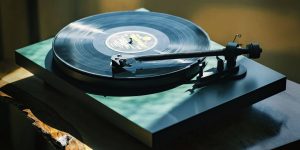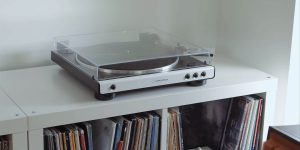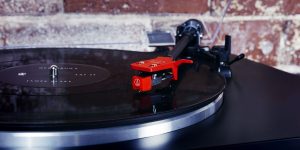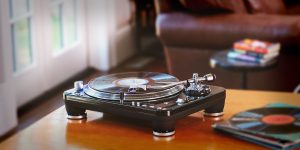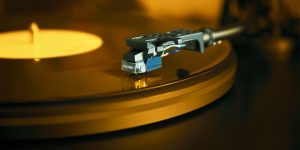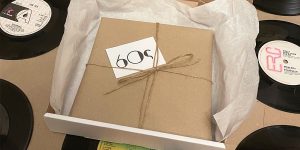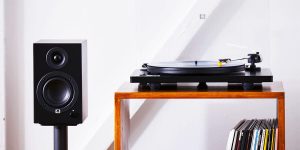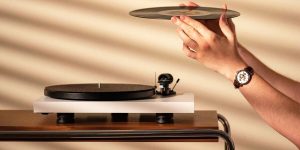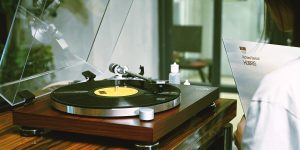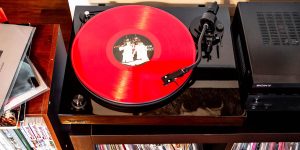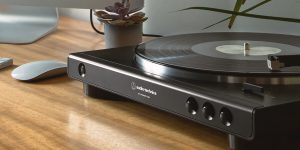In the world of vinyl, finding the best turntables under $500 can often strike the right chord between affordability and quality. While I’ve had the privilege of testing a myriad of models over the years, this particular price range has always intrigued me. These turntables don’t claim to cater to the highest end of the audiophile spectrum. However, they do promise and often deliver a listening experience that feels premium without burning a hole in your pocket.
As a seasoned vinyl enthusiast, I’ve witnessed the evolution of these mid-priced machines. Their growing appeal is evident among beginners and casual listeners prioritizing decent sound quality. So, let’s dive deeper into some of these players that have captured my attention and, I believe, deserve yours as well.
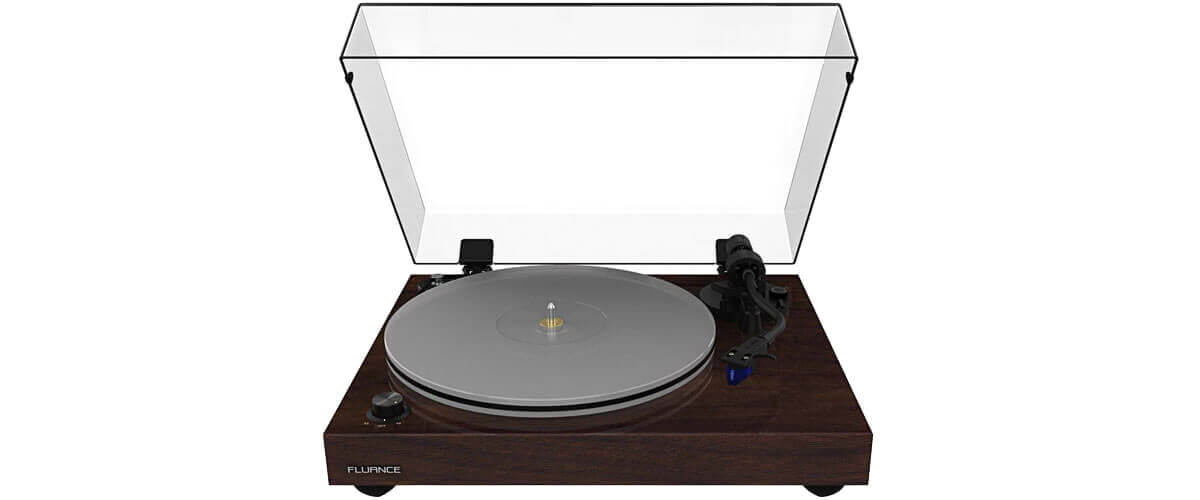
Turntables under $500 comparison table
| Name | Drive type | Operation type | Speeds | Phono Pre-Amp | Bluetooth | Review |
|---|---|---|---|---|---|---|
| Fluance RT85 best overall | belt | manual | 33 1/3, 45 RPM | yes | no | Review |
| Denon DP-300F also great | belt | semi-automatic | 33 1/3, 45 RPM | yes | no | Review |
| Audio-Technica AT-LPW50PB | belt | manual | 33 1/3, 45 RPM | yes | no | Review |
Best turntable under $500 reviews
Fluance RT85 – best overall

When I first got my hands on the Fluance RT85, I was genuinely curious. I’ve encountered various turntables in this price bracket, but this one piqued my interest. The inclusion of the Ortofon 2M Blue Elliptical Cartridge was unexpected – it’s the kind of feature typically reserved for pricier models.
The acrylic platter? Beyond its good looks, it felt stable without the usual mat. A subtle yet appreciated difference. As for its isolated motor and speed control, I have to admit, it was refreshing to hear my records without the usual background hum or vibration. It’s those quiet details that sometimes make all the difference.
This model doesn’t have an onboard preamp. However, it can be seen in two lights: a miss or an opportunity to customize your sound journey.
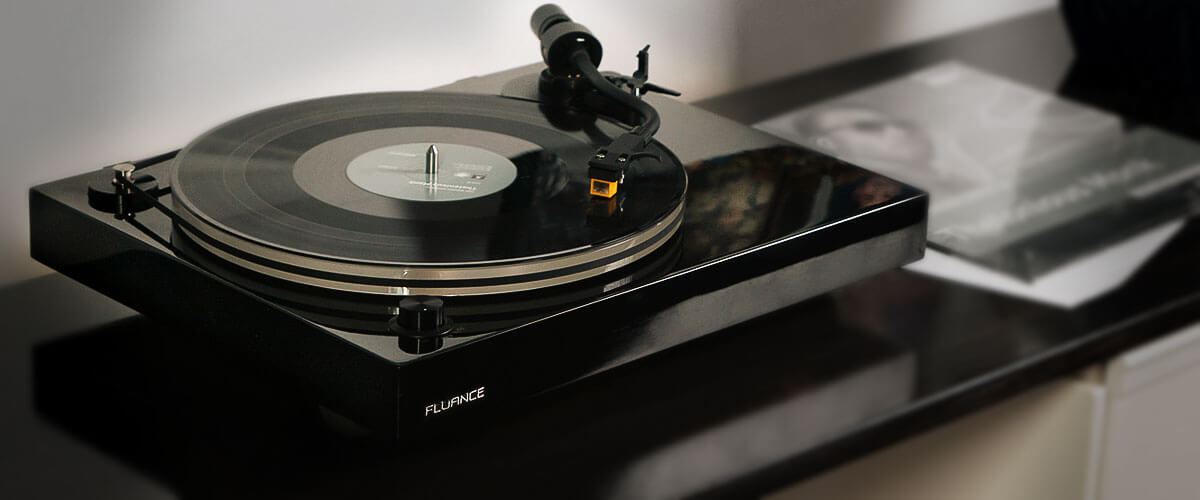
On my own listening spree with the RT85, spinning classics like Pink Floyd’s “Dark Side of the Moon,” there was an undeniable warmth and clarity, especially with older tracks. I love the way the cartridge delivers a bright, flat sound profile with a well-distributed soundstage. But, of course, it doesn’t quite match the intensity of some higher-end models I’ve encountered.
Comparing the Fluance RT85 and the Denon DP-300F, both have their strengths in the sub-$500 domain. The Denon DP-300F shines with its adaptability and potential for future upgrades. However, the RT85, with its Ortofon 2M Blue Elliptical cartridge and precision-engineered acrylic platter, resonates more with my personal preferences. These specific features give it a subtle edge, making it my top pick for a genuine vinyl listening experience.
The Fluance RT85 undoubtedly stands out in its category, making a compelling case for those in pursuit of the overall best turntable under $500. With its thoughtful classic features and attention to detail, it offers both authentic and refined sound quality. I’m sure it won’t disappoint you!
Key specs
- Drive type: belt.
- Operation type: manual.
- Speeds, RPM: 33 1/3, 45.
- Phono Pre-Amp: no.
- Bluetooth: no.
- USB: no.
- Aux input: no.
Pros
- Sleek and modern look with a hefty feel.
- Accurate speed, reduced wow and flutter, and the Ortofon 2M Blue cartridge enhances overall sound quality.
- Easy assembly and setup – can be up and running within an hour of opening the box.
Cons
- The arm matches the provided cartridge, but it is not right for other brands without modifications.
- The three-point mounting system is not suitable for DJs or rough handling.
Denon DP-300F – also great
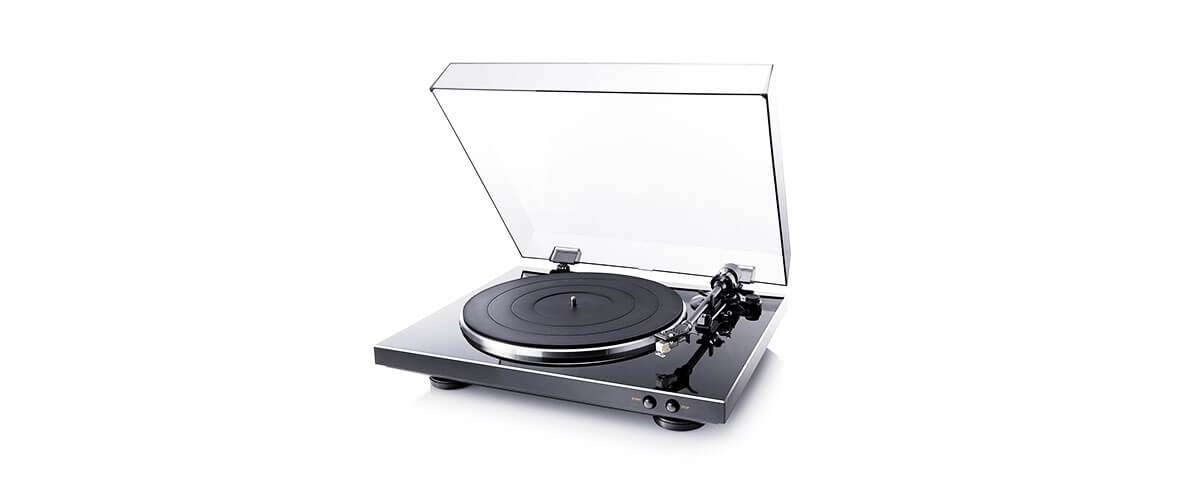
The Denon DP-300F is a clear testament to the power of blending old-world charm with contemporary functionality. Out of the box, its sleek and minimalist design speaks of Denon’s commitment to aesthetic elegance without compromising the audio experience. If crafting record players is an art, then in my eyes, the DP-300F is undoubtedly one of Denon’s most striking masterpieces.
At its heart lies a built-in phono preamp, a feature absent in many competitors, which allows it to connect to modern amplifiers or powered speakers easily. This inclusion is a nod to the user-friendly nature of the turntable, ensuring that even vinyl novices can set it up without much fuss. Yet, for those who want more control over their sound, this preamp can be effortlessly bypassed.
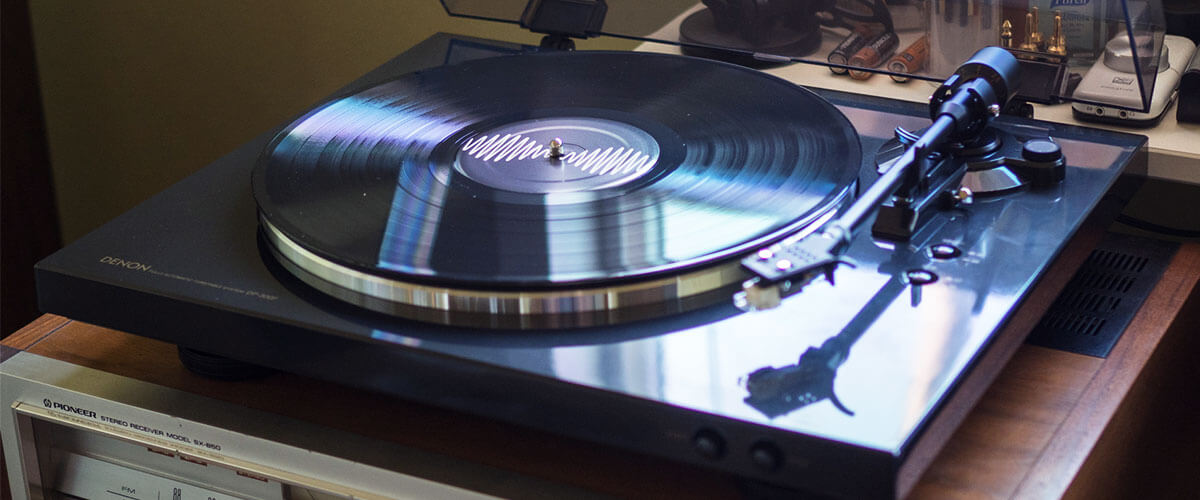
However, not everything is a symphony with the DP-300F. Some purists might find its automatic features, like the auto start-stop and the arm lift, a tad invasive. Though for many, especially those new to vinyl, these features are a modern convenience that spares the stylus and the records from potential mishaps.
When I settled down for a listening session, the DP-300F told stories with lively clarity. Jazz tracks came alive in my room, and rock anthems throbbed with energy, perhaps because of its sturdy build that keeps vibrations at bay. Still, I sensed a comforting warmth in its sound, taking me back to vinyl’s golden days. However, if I were to nitpick, there’s a subtle softness in the highs that purists might pick up on.
In conclusion, the Denon DP-300F emerges as a harmonious blend of design, practicality, and sound integrity. It underscores the timeless allure of vinyl in today’s digital era. For those on the hunt for the best record player under 500 that merges contemporary ease with sonic excellence, the DP-300F surely captures the attention.
Key specs
- Drive type: belt.
- Operation type: semi-automatic.
- Speeds, RPM: 33 1/3, 45.
- Phono Pre-Amp: yes.
- Bluetooth: no.
- USB: no.
- Aux input: no.
Pros
- Excellent build quality – solid, beefy knobs, heavy, precise counterweight, improved tonearm clamp.
- 3 speeds and on-the-fly speed selector.
- Reliable end-of-side shut-off and arm lift mechanism.
- Straightforward setup, with a helpful guide included.
Cons
- The included cartridge is basic.
- Not as heavy as some models, which can be both good (easy to place/move) and potentially bad (less resistance to vibrations).
Audio-Technica AT-LPW50PB
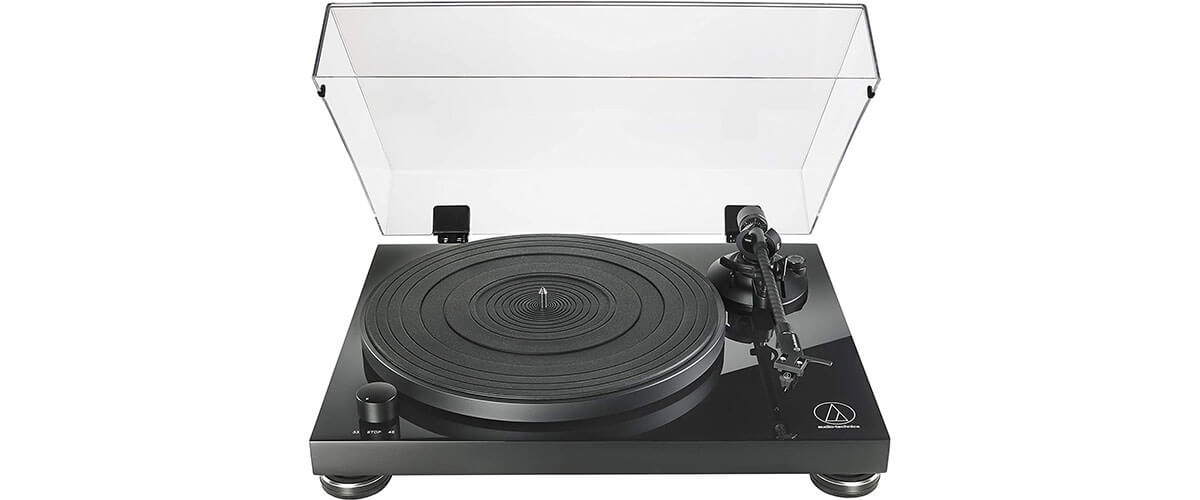
Renowned for precision and reliability, Audio-Technica turntables resonate with both casual listeners and audiophiles alike. Their AT-LPW50PB model is nestled comfortably in the mid-priced range, offering an interesting solution for those who need decent quality for a reasonable price.
This TT showcases a sleek veneer finish, appealing to modern sensibilities without screaming ‘cheap’. Diving into its operational aspects, the fully manual mechanism might seem a bit old-school to some. But, as any seasoned vinyl enthusiast will tell you, manual operation offers a tangible connection to your music, making the experience intimate and immersive.
One of the player’s standout features, undoubtedly, is the speed-sensor system. In the realm of vinyl, even a minor fluctuation in platter rotation can significantly affect sound fidelity. The AT-LPW50PB ensures you don’t have to grapple with such nuances, maintaining its two operational speeds with commendable accuracy.
I also love its adjustable dynamic anti-skate control. It ensures that the stylus remains balanced within the groove of the record. This optimizes playback and protects your precious vinyl from potential damage.
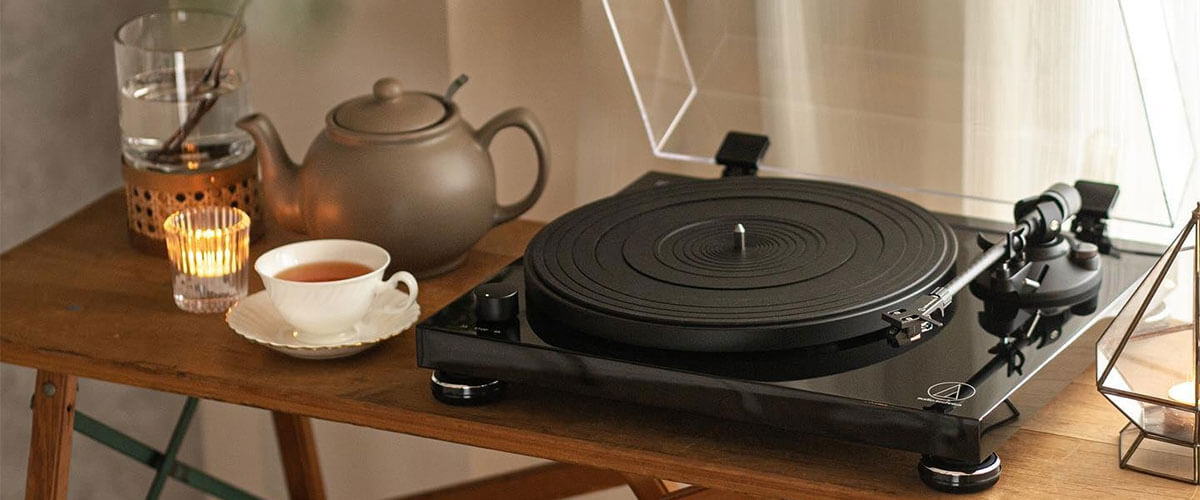
When we talk about sound quality, it’s clear that this isn’t poised to compete with premium or audiophile-level players. Yet, it manages to deliver a sound that’s rich and wraps around, breathing life into the vinyl grooves. The carbon fiber tonearm, typically found in higher-end models, is a pleasant addition. Whether it drastically improves sound quality is debatable, but it definitely adds a touch of class and durability.
However, it’s not all roses. Some users might find a slight rumble at high volumes, a small hiccup in an otherwise smooth experience. Whether this is a deal-breaker or a minor inconvenience will depend on individual preferences.
To round it off, the onboard preamp and the removable headshell and cables cater to those who love tinkering and upgrading. It’s evident that Audio-Technica has put thought into the longevity and adaptability of this table.
In conclusion, the Audio-Technica AT-LPW50PB stands out as a good choice for those seeking a reliable vinyl player under $500. It prioritizes consistent performance over flashy features, offering value without compromising quality.
Key specs
- Drive type: belt.
- Operation type: manual.
- Speeds, RPM: 33 1/3, 45.
- Phono Pre-Amp: yes.
- Bluetooth: no.
- USB: no.
- Aux input: no.
Pros
- The sleek veneer finish gives it a modern yet classic look.
- Comes with the upgradable VM95E needle.
- Removable headshell and cables allow for future upgrades.
Cons
- Rumble observed at high volumes.
- Power on/off switch placement (on the back) may be inconvenient for some.
Pro-Ject T1 Phono SB
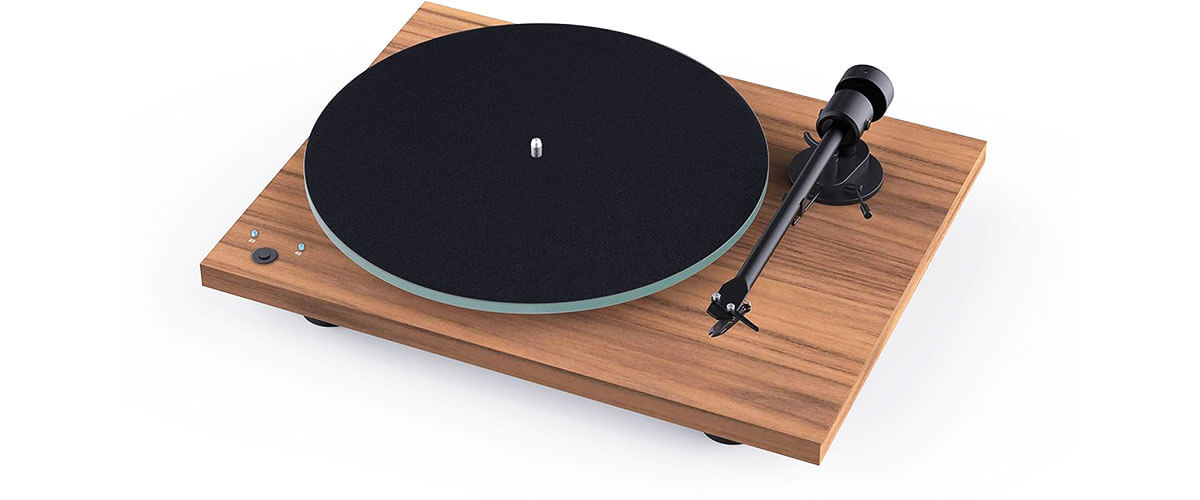
Having spent some time with the Pro-Ject T1 Phono SB, I must say it pleasantly bridges the gap between affordability and performance. At first glance, its bead-blasted 8mm glass platter immediately caught my attention, hinting at a blend of style and functionality that many record enthusiasts, including myself, appreciate.
The factory-configured tonearm and cartridge saved me significant setup time. Honestly, there’s a joy in bypassing the often-tedious alignment process and diving straight into the music. Mechanically, the turntable felt solid. The electronic speed selection for 33 1/3 and 45 RPM was intuitive, making it easy to switch between my eclectic mix of vinyl. For those looking for a plug-and-play experience, the built-in phono preamp, which is also bypassable, is an invaluable feature. As a record player with a preamp, it simplifies the connection process to various audio systems.
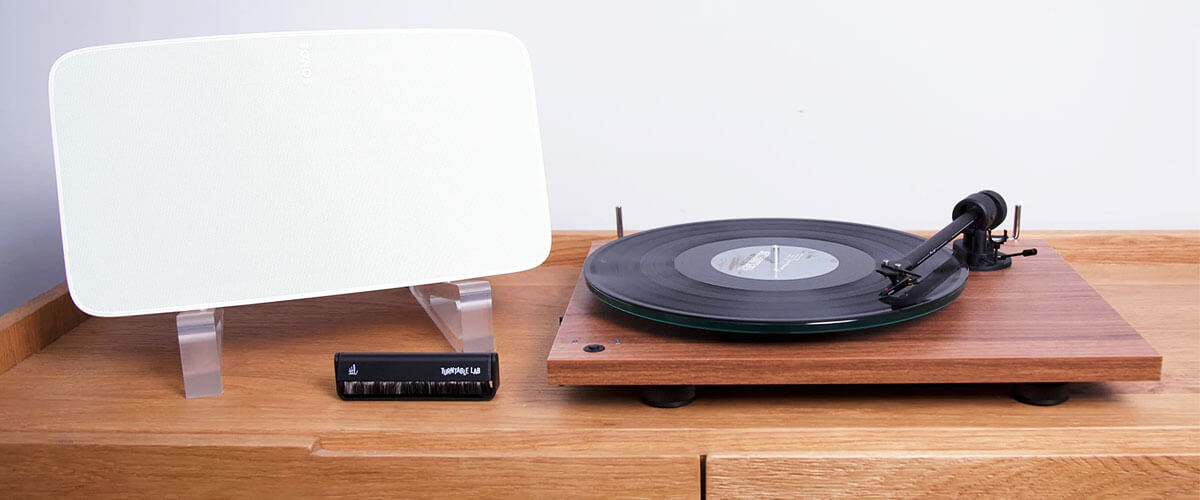
Listening to this babe was a treat. The slightly warm tone brought a comforting hue to my classics, and the channel separation was impressive, letting me distinctly enjoy every instrument. The attached cables were a bonus, eliminating the hunt for compatible ones.
However, it wasn’t all smooth sailing. During my testing, I experienced the tonearm skipping a beat on a couple of records. And yes, there was that moment of mild panic when one of my beloved records seemed snug on the spindle. A gentle wiggle did the trick, but it’s something to watch out for.
In sum, the Pro-Ject T1 Phono SB shines with its pre-installed Ortofon cartridge, easy setup, and built-in phono preamp. Its understated design complements a pretty good sound profile, making it an attractive option for vinyl enthusiasts who value both aesthetics and reliable performance in their record player selections.
Key specs
- Drive type: belt.
- Operation type: manual.
- Speeds, RPM: 33 1/3, 45.
- Phono Pre-Amp: yes.
- Bluetooth: no.
- USB: no.
- Aux input: no.
Pros
- Clear and natural sound output.
- Elegant design.
- Pre-installed Ortofon cartridge and factory setup tonearm make for a hassle-free installation.
- Notable for its onboard phono preamp and quality attached cables.
Cons
- The tonearm is prone to skating or skipping at the start of records.
- Lightweight build – may lead to stability and quality issues of the internal components.
- Hidden power button – while some appreciated the aesthetic, others found it awkward to use, potentially moving the turntable when toggling.
What to look for when choosing a record player under $500
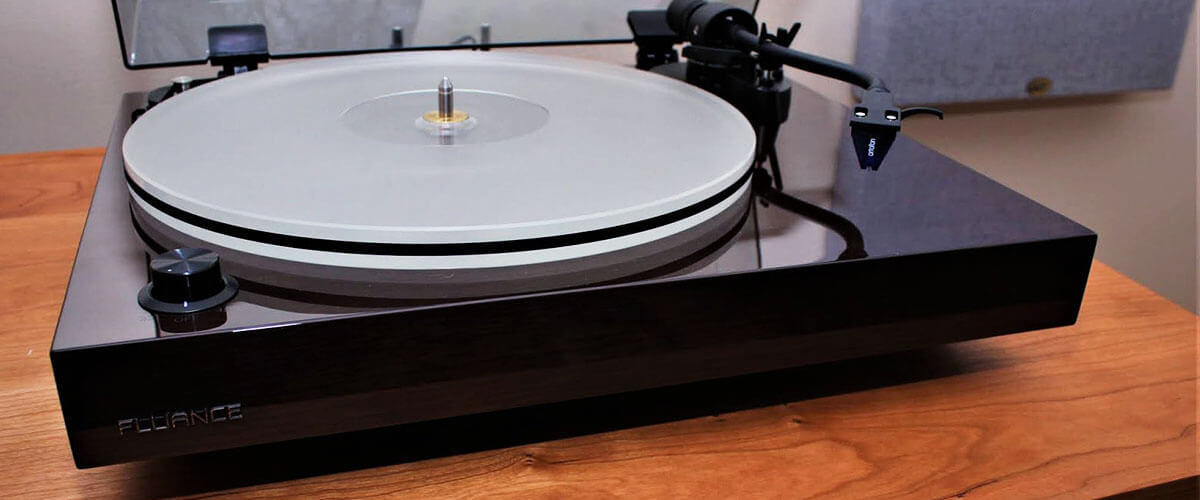
Choosing the right turntable can be challenging, especially with so many available options. In this part of my review, I want to emphasize the main factors you should pay attention to when making your selection of top turntables under $500.
Manual vs. automatic operation
Have you ever been to a nostalgic vinyl party and watched the DJ gracefully place the needle onto the record? That’s a manual operation in its purest form. On the other hand, imagine a scenario where, with just a button press, the magic unfolds without you having to do the needle drop. That’s the charm of an automatic turntable.
Manual turntables offer more control and are often favored by purists and audiophiles who prefer a hands-on experience. It can give you a deeper connection with your music, but there’s also a steeper learning curve, especially for beginners.
Automatic turntables, however, make the process straightforward. With a simple push of a button and the tonearm moves, the platter begins to spin, and music fills the room. They’re fantastic for those who prefer ease and convenience, especially if you’re worried about damaging your precious records.
Ultimately, the choice between manual and automatic comes down to personal preference. Do you yearn for an intimate, tactile experience or the simple joy of effortless listening? Decide based on your own musical journey.
Drive Type: belt-drive vs. direct-drive
The heart of every turntable lies in its drive system, and the age-old debate rages on: belt-drive or direct-drive? But what’s all the fuss about?
Belt-drive turntables are known for their quiet operation. The motor is separated from the platter by a rubber belt, isolating most vibrations. This setup is often preferred by casual listeners and even makes its way into some audiophile turntable setups due to its noise-reducing qualities.
On the flip side, direct-drive turntables have the motor directly connected to the platter. This design offers stronger torque and faster start-up times, making them a favorite among DJs. Plus, they tend to be more durable in the long run.
However, each has its strengths. Belt-drives offer pristine sound quality by reducing vibrations, while direct-drives boast robustness and speed. Think about your primary purpose – are you mixing beats or sinking into a cozy listening session? Your answer will point you in the right direction.
Phono preamp: built-in vs. external
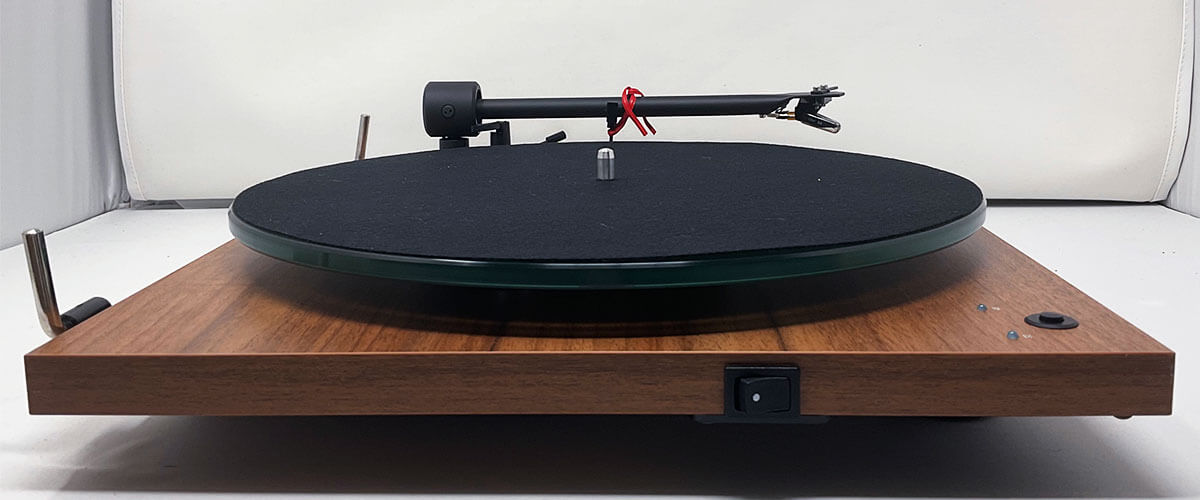
Diving into the vinyl world introduces us to some techy terms, and “phono preamp” is definitely one of them. Simply put, a phono preamp boosts the tiny signals from your turntable to a level your speakers or amplifier can understand. Now, do you go built-in or external?
Turntables with built-in phono preamps are the embodiment of convenience. Just connect to your speakers, and you’re set. Great for beginners or those who prefer a more straightforward setup, they often come at a more budget-friendly price point.
On the other hand, external phono preamps offer a touch of customization. For the budding audiophile, this means a chance to upgrade and fine-tune your sound over time. While this might sound like an additional chore, the difference in sound quality can be substantial for the discerning ear.
The choice boils down to your commitment level and desired sound quality. Are you in for the deep dive or just skimming the surface? Both paths have their merits.
Tonearm
The tonearm is like an orchestra conductor, guiding the music’s flow from vinyl to your eager ears. Its primary role? To ensure the stylus navigates the record grooves with precision.
In the models within our budget range, tonearms are often made of aluminum or carbon. Aluminum is renowned for its lightweight yet sturdy nature, making it a popular choice for many turntables. It offers stability without adding unnecessary weight. Carbon, on the other hand, is praised for its rigidity and ability to dampen unwanted resonances, often delivering a cleaner sound.
A well-designed tonearm ensures consistent pressure, preventing skips and reducing wear on your records. Whether S-shaped or straight, the material and design play significant roles in the final audio output.
To sum up, when shopping, focus on a tonearm that feels solid and offers adjustable counterweights.
Cartridge
A cartridge is like the narrator of your favorite story – it brings the tale to life. This little component houses the stylus (or needle) and translates those intricate grooves on your vinyl into the melodies we cherish.
Good news for my readers: the players highlighted in this article come equipped with solid cartridges from reputable manufacturers. What does this mean for you? A dependable, consistent sound right out of the box. No need to embark on an immediate upgrade journey!
While cartridges can be upgraded for those seeking an even finer sound, starting with a reliable one saves both time and money.
Plinth
The plinth, often referred to as the base or chassis, is the unsung hero of any turntable. Acting as a foundation, it’s essential in minimizing unwanted vibrations that could distort sound. The mantra here? Heavier and more stable equals better.
In the sub-$500 category, we commonly see bases made of metal, carbon, and acrylic. Metal offers heft and durability, carbon brings in stiffness coupled with lightweight properties, and acrylic provides excellent vibration damping. Each material has its strengths in preserving the purity of sound.
When choosing a turntable, don’t overlook the plinth. A robust foundation is key to enjoying those favorite tracks without any interference.
We are supported by our audience. When you purchase through links on our site, we may earn an affiliate commission at no extra cost to you.
Our newsletter
* We will never send you spam or share your email with third parties


![Best Turntables Under $100 [Reviewed and Tested]](https://righttechadvice.com/wp-content/uploads/2023/09/best-turntable-under-100-300x150.jpg)
![Best Turntables Under $300 [Reviewed and Tested]](https://righttechadvice.com/wp-content/uploads/2023/10/best-turntable-under-300-review-300x150.jpg)
![Best Record Players Under $200 [Reviewed and Tested]](https://righttechadvice.com/wp-content/uploads/2023/10/best-turntable-under-200-300x150.jpg)
